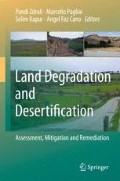Abstract
This study assessed the effectiveness of the existing land conservation techniques in the peri-urban area of Kaduna metropolis with the aim of ascertaining if the existing conservation methods have helped to alleviate land degradation, and provide sustainable land use. Random sampling method was used to collect data from field observation, measurement and semi-structured interviews, which are analysed using descriptive statistics. The results revealed that there exist local conservation techniques along with the modern ones, some are physical and others are biological methods, even though techniques such as agroforestry, which is known to be the best method of farming is present but is yet to take root in the area. Some of these conservation methods are not standardized neither are they implemented in a scientific manner to ensure effectiveness and efficiency without causing further damage to the land, and there may be no end to land degradation in Kaduna if the current approaches to conservation are not improved on. It is suggested that improved water management, improved farming techniques, economic empowerment and education of the land users be employed in refining existing techniques, through which poor management practices such as bush burning, mono-cropping and overgrazing will be avoided while farmers may easily embrace new practices such as agroforestry, which provides farmers with income and food all year round as well as protect the environment from further degradation.
Access this chapter
Tax calculation will be finalised at checkout
Purchases are for personal use only
References
Adeoye, K.B. (1990). Effects of amount of mulch and timing of mulch application on maize at Samaru, Northern Nigeria. Samaru Journal of Agricultural Research 7:57–66.
Adewumi, J.K. and Kolawole, A. (2002). Water harvesting for dryland farming. The Zaria Geographer 15(1):24–33.
Ben Hassine, H., Aloui, H. and Amdouni, M. (1998). Evolution mensureelle des reserves en azote mineral dans deux types de sols cerealiers, sous climat sub-humidedu word-quest de la Tunisie, campanes agricoles 96-97 et 97-98 Tunis; direction des sols, ministere de sols, minstere de l’ agriculture.
Bielders, C.L., Alvey, S. and Cronyn, N. (2001). Wind erosion: The perspective of grass-root communities in the Sahel. Land degradation and development 12(1):57–70.
Bodunde, J.G. and Ogunwole, J.O. (2000). Productivity of tomato (Lycopersicon Esculentum mill.) genotypes grown on residual soil moisture. The plant scientist 1(1&2):115–125.
Butterbury, S.P.J. (2001). Landscapes of diversity: A local political ecology of livelihood diversification in south-western Niger. Ecumene 8(4):437–464.
Dogo, B. (2006). Problems and prospects of agriculture as a secondary occupation amongst military personnel in Ribadu Cantonment-Kaduna. The academy journal of defence studies 12:125–136.
Gadzama, N.M. (1995). Sustainable development in the arid zone of Nigeria, monograph series, No 1, centre for arid zone studies. University of Maiduguri, pp. 1–32.
Hamrouni, H., Mtimet, A., Morel, C. and Moutonnet, P. (2001). Acquisition de valeurs de references pour raisonner la fertilite phosphate de deux sols calcaire de Tunisie central cultives en ble. Tunis: Direction des sols and Vienna: International Atomic Energy Agency (IAEA).
Harou, P.A. (2002). What is the role of markets in altering the sensitivity of arid land systems to perturbation. In: J.F. Reynolds and S. Stafford (eds.), Global desertification: Do humans cause deserts? Workshop Report 88. Dahlem University press, Berlin, pp. 253–274.
IRA (Instit des Regions Arides). (1991). Seminaires national sur la lutte centre la desertification 4–6 decembre 1989. Revue des regions arides. Numero special. Medenine, Tunisia.
Mariko, K.A. (1991). Reforming land tenure and restoring peasants’ rights: Some basic conditions for reversing environmental degradation in the Sahel, IIED, Dryland networks programme, issue paper No. 24.
Mortimore, M. (1998). Roots in the African Dust: Sustaining the Sub-Saharan Drylands. Cambridge University press, UK.
Mtimet, A., Attia, R. and Hamrouni, H. (2002). Evaluating and assessing desertification in arid and semi-arid areas of Tunisia: Process and management strategies. In: J.F. Reynolds and S. Stafford (eds.), Global desertification: Do humans cause deserts? Workshop report 88. Dahlem university press, Berlin, pp. 197–214.
Ogunwole, J.O., Alabi, S.O. and Onu, I. (2003). Evaluation of three long staple lines of cotton to levels of fertilizer under moisture stressed and unstressed conditions. Crop Research 25(1):50–57.
Ogunwole, J.O. and Raji, B.A. (2001). Tillage methods and fertilizer effects on soil phosphorus distribution and yield of late sown cowpea in a Typic Haplustalf. Nigeria Journal of Biological Sciences 1:43–49.
Ogunwole, J.O., Yaro, D.T., Bello, A.L. and Lawal, A.B. (2002). Soil conservation technologies in the sustenance of soil productivity in northern Nigeria. The Zaria Geographer 15(1):103–112.
Rayar, A.J. (1995). Desertification and soil degradation in arid and semi-arid regions of Nigeria. Inaugural Lecture Series 55:1–30.
United, N. (1994). UN Earth summit convention on desertification. UN conference on environment and development, Rio De Janeiro, Brazil, June 3–14, 1992.DPI/SD/1576. New York.
United Nations Environmental Programme. (1985). Desertification control in Africa. Desertification control programme activity centre. UNEP actions and directory of institutions. Nairobi 1:126 pp.
Warren, A., Batterbury, S.P.J. and Osbahr, H. (2001). Soil erosion in the Sahel of West Africa: A review of research issues and an assessment of new approaches. Global environmental change-human and policy dimensions 11(1):79–95.
Author information
Authors and Affiliations
Corresponding author
Editor information
Editors and Affiliations
Rights and permissions
Copyright information
© 2010 Springer Science+Business Media B.V.
About this chapter
Cite this chapter
Adewuyi, T.O. (2010). Assessment of the Existing Land Conservation Techniques in the Peri Urban Area of Kaduna Metropolis, Nigeria. In: Zdruli, P., Pagliai, M., Kapur, S., Faz Cano, A. (eds) Land Degradation and Desertification: Assessment, Mitigation and Remediation. Springer, Dordrecht. https://doi.org/10.1007/978-90-481-8657-0_11
Download citation
DOI: https://doi.org/10.1007/978-90-481-8657-0_11
Published:
Publisher Name: Springer, Dordrecht
Print ISBN: 978-90-481-8656-3
Online ISBN: 978-90-481-8657-0
eBook Packages: Earth and Environmental ScienceEarth and Environmental Science (R0)

